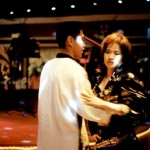Dir. by Hou Hsiao-Hsien
Images: Hou cuts constantly between scenes set in contemporary Taiwan, which are in full color, and scenes from the film-within-the-film, which are a tinted black and white. This allows the director to be more traditionally “cinematic” in the filmed footage — beautiful shots of trees, prison hallways, light fixtures. Favorite images: the self-reflexive shots of the actors in costume posing for photos; all of the moments that reveal the emotional intimacy between Liang and Ah Wei; the amazing move from black and white back to color in the penultimate shot.
• • •
The first cut in Good Men, Good Women establishes several dichotomies that, over the next 100 minutes, are beautifully dismantled for explicitly political purposes. The film opens with a long, static, black and white shot of an ancient mainland village. Toward us marches a small group of peasants (we are led to believe), who sing joyfully as they snake closer to the camera before finally exiting to the right of the frame. The sudden cut to a fluorescent apartment in contemporary Taiwan is made all the more jarring by the obnoxious sound of a clamoring telephone. A young woman rises slowly from her bed, retrieves the phone (no answer), sips from bottled water, then tears a sheet of paper from her fax machine. The remainder of the film rewrites the forgotten narratives that connect these seemingly opposed worlds: mainland China and Taiwan, the past and present, truth and fiction, the personal and political.
The young woman, we eventually learn, is Liang Ching (Annie Shizuka Inoh), an actress who is preparing for her role as Chiang Bi-Yu in an upcoming film called, interestingly enough, Good Men, Good Women. This film within the film tells the true-life story of Chiang and her husband, Chung Hao-Tung (Giong Lim), who moved to the mainland in 1940 in order to join the anti-Japanese resistance movement. Chiang would eventually be forced to give up her children for the cause, and would be widowed by it as well. By cutting constantly between the “real world” of Liang’s life and black and white footage from the completed film, Hou blurs the boundaries that might otherwise separate Taiwan from its past, the actress from her role.
And yet even that complex description is a gross oversimplification of Hou’s narrative, which further problematizes any simple notions of the “present” by adding to the mix sequences from Liang’s recent past. Five years earlier, she had been a promiscuous, drug-addicted bar maid, who had found solace only in her relationship with the surprisingly tender gangster, Ah Wei (Jack Kao). Liang is forced to revisit this period of her life when a stranger steals her diary and begins faxing pages of it to her. It’s a remarkable story-telling device, allowing Hou to sound echoes of Chiang’s experience through these various versions of the actress who plays her. The women (all played, of course, by Inoh) share so much in common — in particular, the timeless sorrow over lost lovers and children — but, as the film forces us to acknowledge, the selfless struggle of Chiang’s generation has been realized, tragically, in only the empty consumerism of Liang’s.
In lesser hands, a film like Good Men, Good Women would likely collapse into either a turgid technical exercise or a vehicle for didactic moralizing, but Hou avoids both traps by investing his characters with recognizable life. The film’s most joyful moments emerge from Liang’s and Ah Wei’s lazy familiarity with one another. Like Godard thirty years before, Hou allows his camera to capture the Gangster and His Girl at their most ordinary — impromptu dances in their bedroom, everyday conversations about their future. When watching Flowers of Shanghai and Puppetmaster, I am often frustrated by Hou’s elliptical style, but here — perhaps because of the nonlinear narrative — I feel as though I am being granted brief glimpses into beautifully rich lives. Knowing that Liang’s happiness, like Chiang’s, will be short-lived makes her/their struggle all the more compelling.
Good Men, Good Women would make a textbook study of aesthetic harmony in function and form. Unlike so many recent American films that have reordered the traditional narrative in service of empty excitements or trite analyses of “postmodern truth,” Hou’s cuts and splices history into a well-told tale, revealing those relationships between action and consequence that are so easily elided in our short-term, soundbite memories. Like fellow Taiwanese director Tsai Ming-Liang’s Vive L’Amour, Good Men, Good Women concludes with a remarkable image of mourning, but here the scene is tempered by some promise of potential change. The film ends as it began: with the sight of those marchers, their identities now revealed to us, and with the joyful sound of their voices echoing through the mountains.
